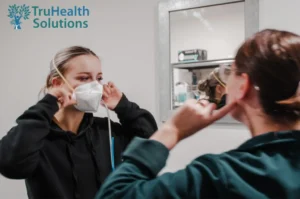Across Australia, drug and alcohol testing underpins safety in aviation, mining, transport, construction and scores of other sectors. Since 2008, most organisations have relied on AS/NZS 4308:2008 to collect, screen and confirm urine specimens for drugs of abuse. In late-2023 Standards Australia released a major revision of that document. The new edition, AS/NZS 4308:2023, resets benchmark procedures, changes several cut-off levels, tightens chain-of-custody rules and introduces a formal transition period that ends in December 2026. Employers who keep using the 2008 framework after that deadline risk invalid test results, unfair-dismissal findings and WHS penalties that can climb into the millions of dollars. Because the stakes are high and the calendar is already ticking, understanding what changed, when those changes must be in place and how to roll them out has become a business-critical priority.
What AS/NZS 4308:2023 covers – and what it does not
The standard specifies procedures for collecting urine, screening it on-site if desired, sending presumptive positives to a laboratory, confirming them by mass-spectrometry and reporting results. It sets mandatory detection (screening) and quantitation (confirmation) thresholds for drug classes that include cannabinoids, cocaine metabolites, opiates, amphetamine-type stimulants and benzodiazepines. The document does not govern oral-fluid testing, breath-alcohol testing or hair analysis; those fall under AS 4760 and other methods. Nor does it override privacy statutes, industrial instruments or enterprise agreements, although it is routinely referenced by the Fair Work Commission, WorkSafe regulators and courts when they weigh the defensibility of a test.
The five headline changes between 2008 and 2023
The 2023 revision is more than a cosmetic refresh. It revises language throughout, reorganises clauses for clarity and, most importantly, introduces substantive technical amendments.
First, specimen collection procedures now mandate an electronic or paper chain-of-custody form that travels with every sample from donor to laboratory. The older edition merely recommended a paper form.
Second, the standard tightens security around sample handling. Collectors must seal transport bags with tamper-evident adhesive that leaves an irreversible mark if disturbed. The earlier text allowed resealable zip locks provided they were heat-sealed.
Third, screening technology requirements step up. The 2023 version states that on-site immunoassay devices must demonstrate ongoing lot-to-lot verification against quality-controlled urine before every shift. Under the 2008 document, annual verification sufficed.
Fourth, the laboratory confirmation window changes from five business days to three calendar days. This compresses the timeframe in which organisations must courier presumptive positives to a NATA-accredited laboratory.
Finally, several cut-off levels move. Amphetamine screening drops from 300 µg/L to 150 µg/L, while benzodiazepine confirmation rises from 50 µg/L to 100 µg/L to reflect improved analytical specificity. These numerical adjustments directly affect how often results return as positive or negative, which in turn influences disciplinary thresholds, fatigue-management models and rehabilitation referrals.
Updated drug panels and thresholds under AS/NZS 4308:2023
| Drug class | Screening cut-off 2008 (µg/L) | Screening cut-off 2023 (µg/L) | Confirmation cut-off 2008 (µg/L) | Confirmation cut-off 2023 (µg/L) |
|---|---|---|---|---|
| Cannabinoids (THC-COOH) | 50 | 50 | 15 | 15 |
| Cocaine metabolites | 300 | 150 | 150 | 100 |
| Opiates (morphine codeine) | 300 | 300 | 150 | 150 |
| Amphetamine-type (AMP, M-AMP) | 300 | 150 | 150 | 100 |
| Benzodiazepines | 200 | 200 | 50 | 100 |
| Synthetic opioids (new class) | n/a | 100 | n/a | 50 |
Employers will instantly notice two points. First, lower screening limits for cocaine and stimulants mean more presumptive positives in environments where occasional recreational use once slipped under the radar. Second, confirmatory cut-offs for benzodiazepines double, reducing the likelihood that legitimate therapeutic doses trigger disciplinary action. The addition of a synthetic-opioid panel recognises the increasing prevalence of tramadol and oxycodone in both legitimate medical and diverted contexts.
The legal landscape surrounding the new standard
The Work Health and Safety Act 2011 creates a primary duty of care for persons conducting a business or undertaking to eliminate or minimise risks to health, so far as is reasonably practicable. Courts consistently interpret that duty to include managing hazards created by drug impairment. Although the Act does not prescribe any particular standard, regulators and tribunals view an AS/NZS 4308-compliant programme as the baseline for evidentiary reliability.
At the federal level the Privacy Act 1988 requires employers to obtain informed consent before collecting specimens and to secure the personal information that results reveal. State transport and mining legislation often adds industry-specific testing obligations; for example, the Road Transport Act 2013 (NSW) makes a positive confirmatory result an offence if found above stipulated thresholds. The Therapeutic Goods Act 1989 intersects where point-of-care devices fall within legal definitions of in-vitro diagnostic equipment.
Fair Work Commission rulings over the past decade confirm that dismissal decisions become vulnerable when employers rely on non-compliant tests. In several unfair-dismissal applications, employers who failed to perform confirmatory GC-MS analysis under AS/NZS 4308 lost because commissioners deemed the screening result insufficient proof. The revised standard will only sharpen that focus.
The official transition timetable and what it means in practice
| Phase | Dates | Compliance milestones |
|---|---|---|
| Familiarisation | Dec 2023 – Jun 2024 | Internal gap analysis, procurement of updated chain-of-custody stationery, initial collector training |
| Implementation | Jul 2024 – Jun 2025 | Validation of new on-site devices, revision of employment contracts, pilot testing under revised procedures |
| Consolidation | Jul 2025 – Nov 2026 | Full operational rollout, NATA surveillance audit, phase-out of legacy equipment and forms |
Any organisation that has not fully adopted the 2023 provisions by December 2026 will struggle to defend the integrity of its programme if an incident occurs. Insurers already signal that policies covering occupational health liabilities may exclude claims tied to outdated practices.
Industry-specific ramifications of the 2023 shift
Transport operators confront higher random-testing hit rates because of the lowered stimulant and cocaine thresholds. Logistic firms with nationwide fleets predict a fifteen per-cent increase in presumptive positives during the first year of the new regime. They therefore budget additional laboratory fees and review fatigue-management rosters to avoid staff shortages while confirmatory results are pending.
Construction companies face a different challenge: high turnover and subcontracting. Ensuring that every subcontractor’s provider follows the 2023 rules demands tighter procurement clauses and spot audits of third-party collection rooms.
Healthcare employers focus on the new synthetic-opioid panel because nurses and paramedics may legitimately use prescribed pain medication. Hospital executives work with occupational physicians to align impairment definitions with the higher benzodiazepine confirmatory threshold, avoiding knee-jerk disciplinary action against staff using medication under supervision.
Building your compliance roadmap
Transition begins with leadership endorsement. Executives should sign off a policy revision that explicitly cites AS/NZS 4308:2023 rather than the superseded 2008 edition. Human resources teams then review employment agreements to ensure testing clauses reference the new document. Procurement officers must verify that on-site kits carry manufacturer validation data at the updated cut-off levels. Collectors retrain on the fresh chain-of-custody form, and laboratories schedule method-development work to meet the three-day confirmation window.
Finance departments model cost impacts: lower screening thresholds will increase the proportion of samples sent to a lab. Early adopters in mining estimate an extra $42 per person tested in the first six months, tapering once employees adjust behaviour. Those costs compare favourably with the potential penalties for a serious WHS breach, which in Queensland can exceed $3.6 million for a corporation.
Information-technology teams must update secure databases so that result fields accommodate the new drug classes and altered cut-off flags. Privacy officers verify that data-retention periods remain lawful under the Privacy Act. Communication specialists roll out toolbox talks and e-learning modules so workers understand why procedures change and how to raise concerns.
Frequently asked questions woven into everyday scenarios
A senior manager might ask whether existing refrigerators in collection rooms meet the new temperature-control rules. The answer is yes if they maintain between two and eight degrees Celsius and carry a monthly calibration log, but no if they lack tamper-evident key control. Another common query involves existing stock of 2008-labelled kits. They may be used only for non-disciplinary health-promotion programmes; any action that could lead to dismissal or legal sanction must rely on 2023-validated devices. Organisations also ask whether medicinal-cannabis users face higher risk under the new thresholds. Because cannabinoid limits remain unchanged, their position stays the same; employers still need a fit-for-duty assessment rather than blanket prohibition.
Case study: an early adopter’s experience
A national rail freight operator with 1200 employees completed its migration by March 2024. Management partnered with a NATA-accredited laboratory to pilot the new chain-of-custody process at two depots. Over three months they found a twelve-per-cent uplift in presumptive positives, but only a three-per-cent rise in final confirmed positives, thanks largely to the higher benzodiazepine confirmation cut-off. The company then negotiated a bundled confirmation rate with its laboratory, reducing per-sample fees by ten per cent compared with ad-hoc pricing. Worker representatives reported higher confidence in the fairness of the system, and no unfair-dismissal claims have arisen since implementation.
Consequences of failing to move by November 2026
Organisations that ignore the new requirements may face multiple fronts of risk. In industrial manslaughter investigations, regulators could argue that reliance on outdated testing constitutes negligence. In unfair-dismissal hearings, employees who test positive on a 2008-calibrated device could claim wrongful termination on procedural grounds. Insurers can deny coverage if policy wording requires compliance with current Australian Standards, leaving employers to bear legal costs.
Looking beyond 2026: continual improvement
Standards evolve as drug trends shift. Synthetic cannabinoids and designer stimulants already appear in emergency-department statistics. The joint standards committee has flagged a mid-2027 review to consider incorporating these substances. Employers who embed a culture of continual improvement, regular policy reviews and close partnerships with laboratories will navigate future updates without disruptive lurches.
Conclusion – from compliance obligation to safety advantage
AS/NZS 4308:2023 is more than a new set of numbers on a page. It represents a maturing of Australia’s approach to workplace impairment: tighter chain-of-custody, sharper analytical tools and thresholds that better distinguish genuine risk from therapeutic use. Organisations that act early, train people thoroughly and invest in robust procedures turn a looming regulatory deadline into a competitive edge. They protect employees, reassure clients and insulate themselves from avoidable litigation. The transition clock is already running; now is the time to map the journey, allocate the resources and embed the habits that will keep your workplace both compliant and genuinely safer for years to come.
This guide is provided by TruHealth Solutions — experts in workplace drug and alcohol screening, drug and alcohol policy development, and Medical Review Officer (MRO) services to help Australian businesses meet AS/NZS 4308:2023 compliance.









